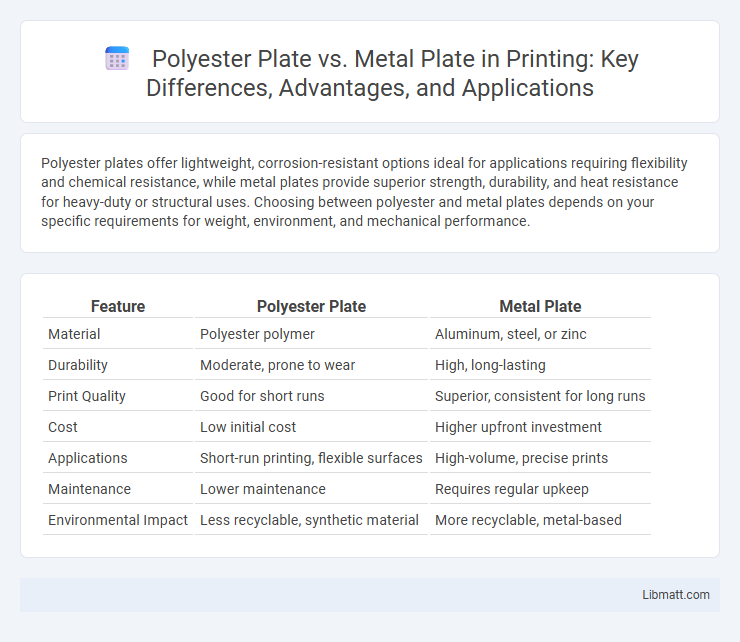Polyester plates offer lightweight, corrosion-resistant options ideal for applications requiring flexibility and chemical resistance, while metal plates provide superior strength, durability, and heat resistance for heavy-duty or structural uses. Choosing between polyester and metal plates depends on your specific requirements for weight, environment, and mechanical performance.
Table of Comparison
| Feature | Polyester Plate | Metal Plate |
|---|---|---|
| Material | Polyester polymer | Aluminum, steel, or zinc |
| Durability | Moderate, prone to wear | High, long-lasting |
| Print Quality | Good for short runs | Superior, consistent for long runs |
| Cost | Low initial cost | Higher upfront investment |
| Applications | Short-run printing, flexible surfaces | High-volume, precise prints |
| Maintenance | Lower maintenance | Requires regular upkeep |
| Environmental Impact | Less recyclable, synthetic material | More recyclable, metal-based |
Introduction to Plate Materials
Polyester plates offer lightweight durability with excellent chemical resistance, making them ideal for applications requiring flexibility and corrosion protection. Metal plates, commonly made from steel or aluminum, provide superior strength and heat resistance, suitable for structural and heavy-duty uses. Your choice between polyester and metal plate depends on the balance between weight, strength, and environmental conditions inherent to your project.
Overview of Polyester Plates
Polyester plates are lightweight, flexible printing plates widely used in flexographic printing for packaging and labels, offering excellent chemical resistance and durability. Compared to metal plates, polyester plates provide faster setup times and cost-effectiveness due to easier handling and quicker processing. Your choice of polyester plates enhances print quality on uneven surfaces while maintaining economic efficiency for short to medium production runs.
Properties of Metal Plates
Metal plates exhibit high tensile strength, excellent durability, and superior heat resistance compared to polyester plates, making them ideal for heavy-duty applications. Their corrosion resistance can vary depending on the alloy composition, with stainless steel offering enhanced protection against rust and chemical damage. Metal plates also possess outstanding thermal conductivity and load-bearing capacity, ensuring stability and longevity in industrial and structural uses.
Key Differences Between Polyester and Metal Plates
Polyester plates offer lightweight, corrosion-resistant properties with excellent flexibility and chemical stability, making them ideal for printing and packaging industries. Metal plates, typically made from aluminum or steel, provide superior durability, heat resistance, and precision for high-volume industrial applications such as stamping and engraving. The key differences lie in polyester's non-metallic composition promoting cost-effectiveness and ease of handling versus metal plates' robustness and longevity suited for heavy-duty mechanical use.
Durability and Longevity Comparison
Polyester plates offer moderate durability with resistance to corrosion and lightweight properties but tend to degrade faster under extreme temperatures or prolonged UV exposure. Metal plates, such as aluminum or stainless steel, provide superior longevity due to high tensile strength, resistance to wear, and ability to withstand harsh environmental conditions without deformation. For applications demanding long-term durability, metal plates typically outperform polyester plates by maintaining structural integrity over extended periods.
Print Quality and Consistency
Polyester plates deliver exceptional print quality with sharp details and vibrant colors due to their smooth surface and consistent ink absorption. Metal plates offer superior durability and resistance to wear, ensuring consistent print performance over long runs without image degradation. Your choice depends on the balance between high-quality, short-run prints from polyester plates and the robust, consistent output provided by metal plates for extended production.
Cost Analysis: Polyester vs Metal Plates
Polyester plates offer a lower upfront cost compared to metal plates, making them a budget-friendly option for short production runs. Metal plates, while initially more expensive, provide greater durability and longer lifespan, reducing replacement frequency and maintenance expenses over time. You can optimize overall costs by weighing the lower initial investment of polyester against the long-term savings metal plates deliver in high-volume applications.
Environmental Impact and Sustainability
Polyester plates generate less environmental waste compared to metal plates because they require lower energy for production and contribute minimally to resource depletion. Metal plates, often made from aluminum, demand intensive mining and processing, which increase carbon emissions and environmental degradation. Your choice of polyester plates over metal can significantly reduce your ecological footprint and support sustainable manufacturing practices.
Typical Applications and Industry Usage
Polyester plates are widely used in printing industries for flexographic printing due to their flexibility, cost-effectiveness, and excellent print quality on materials like plastic, paper, and cardboard. Metal plates, particularly aluminum, are preferred in high-volume commercial printing and packaging sectors for their durability, precision, and superior resistance to wear and chemicals. Your choice depends on application requirements, with polyester favoring short to medium runs and metal plates suited for long production runs in demanding industrial environments.
Choosing the Right Plate for Your Needs
Polyester plates offer lightweight durability and resistance to corrosion, making them ideal for applications requiring flexibility and weather resistance. Metal plates provide superior strength, heat resistance, and longevity, suitable for heavy-duty industrial or structural purposes. Evaluating your project's environmental conditions and load requirements will help determine whether a polyester or metal plate best meets your specific needs.
polyester plate vs metal plate Infographic

 libmatt.com
libmatt.com